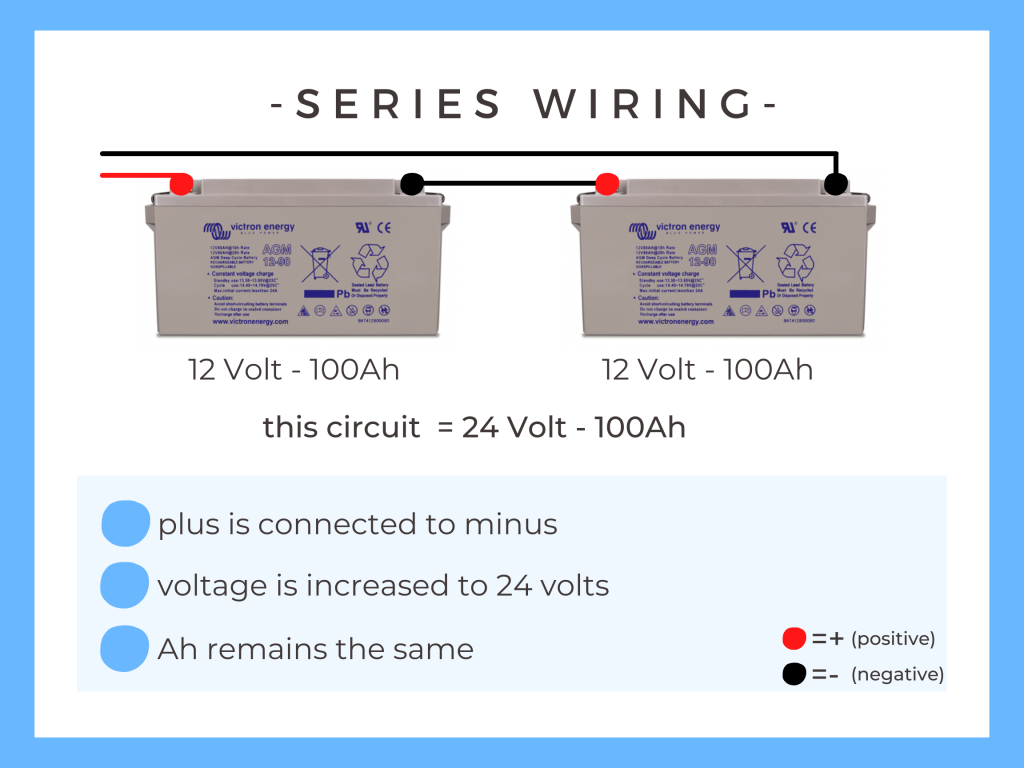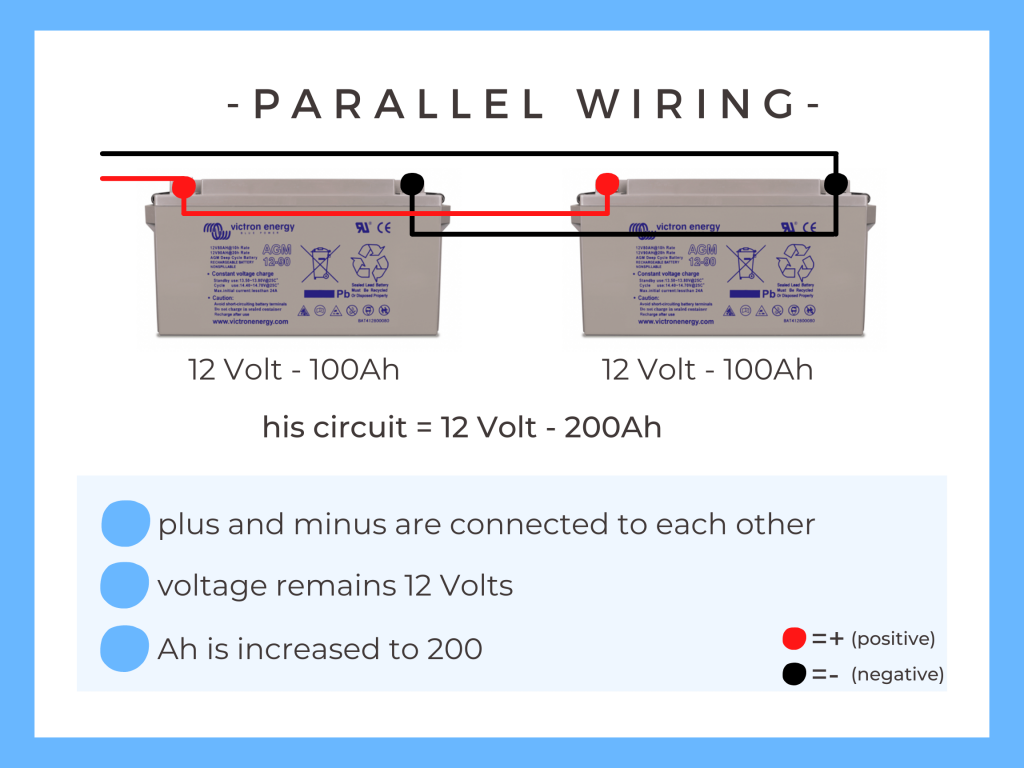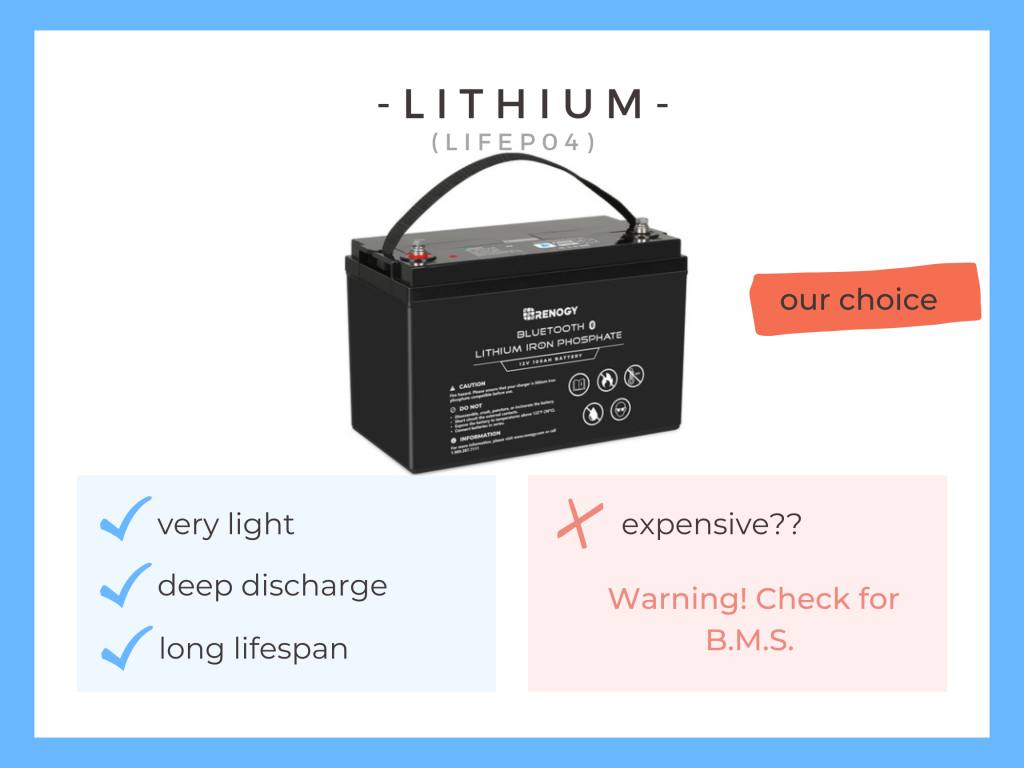The auxiliary battery is the beating heart of your electrical system! In the previous blog post, you already learned a bit about the auxiliary battery. Simply explained: It stores your obtained energy!
1. How does an auxiliary battery work in a Campervan.
A auxiliary battery is an additional battery to your starter battery. You can charge it in different ways. For example, you can connect the interior lights and refrigerator to this battery without draining the starter battery.
Batteries come in different voltages: 12 volts is the most common. With this voltage we will continue in this blog. The capacity of the battery is expressed in ampere hours (Ah). Which leisure battery is right for you is discussed later on.
Important: most (lead-acid) batteries can only be discharged down to 50%.
2. What campervan leisure battery are on the market?
There are a number of different batteries suitable as an auxiliary battery. In this chapter they are conveniently listed so that you can make a better choice. It also explains how you can connect multiple batteries together.
Batteries can be divided into two types: Lead-acid batteries and lithium batteries.
Lead-acid batteries
Semi-traction, AGM , Gell batteries are all lead-acid batteries. These batteries are based on sulfuric acid, lead plates and are therefore very heavy.
Lithium (LiFePO4)
This battery consists of Lithium (Li), Iron (Fe) and phosphate (PO4), the latest technology. Are very compact, light and last longer than lead acid batteries.
Campervan leisure Battery types
It is important to know what types of batteries are available. To make the right choice in the maze of campervan batteries, here are some pros and cons.
Semi-traction battery
Specially designed for regular deep discharging and suitable as an auxiliary battery. Can be discharged up to 80%. However, to increase the lifespan: maximum 50% discharge.
Semi-traction batteries are cheaper than AGM batteries and in most cases do not require maintenance.
The disadvantages of this model are the size and weight; a 235Ah battery easily weighs 57KG and can only be discharged up to 50%. Also, the lifespan of a semi-traction battery compared to an AGM battery is shorter.

AGM battery
Absorbed Glass Mat batteries are equipped with special fiberglass mats. As a result, the batteries cannot leak and can be fixed in any position. They are designed to withstand high and low temperatures, experience little self-discharge and therefore remain usable for a long time.
AGM batteries are more expensive than semi-tracie batteries, but they are also heavy and can be discharged up to 50%. Compared to a Lithium battery, an AGM battery has a shorter lifespan and is therefore more expensive in the long run (if you travel a lot with your campervan). AGM batteries are most commonly used as a leisure battery among van lifers.
Gell battery
Gell batterie are closed just like AGM batteries. This means the batteries cannot leak and can be fixed in any position. They are intended to withstand high- and low- temperatures, experience little self-discharge and therefor remain usable for a long time. A Gell battery can last up to 12 years.
Gell batteries are more expensive than semi-tracie batteries, but are also heavy and can be discharged up to 50%. A Gell battery cannot handle high currents and therefore cannot be charged and discharged too quickly. For this reason, one chooses an AGM battery rather than a Gell battery.

Lithium (LiFePO4)
This type of battery has been on the market for several years and (despite the high price) is gaining ground among vanlifers. These batteries can be discharged up to 95%, are very light compared to the other choices and last a very long time.
Another advantage to these batteries is their low internal resistance. As a result, you quickly charge the battery to 100% and it has a high discharge current. This makes it possible to cook on induction, for example.
The price of lithium batteries is also becoming increasingly attractive. We swapped our Semi Traction battery for a Lithium battery in the summer of 2022. We would recommend a Lithium battery to anyone.
Check whether your (Lithium) battery has a Battery Management System (BMS). This system protects against overcharging and discharging. A Lithium battery in your motorhome is an excellent long-term choice.
3. Wiring posibilites
Series / parallel connection
When installing multiple auxiliary batteries, you can connect them in two ways; in series or parallel circuit.
Series connection
In a series circuit, you connect the minus of one battery to the plus of the other. In this circuit the voltage of both batteries is added together. The capacity (Ah) remains the same.
Advantage of wiring series:
- Higher voltage results in lower current consumption.
- Lower current consumption allows you to use thinner cables.
Disadvantage of wiring series:
- Your products must be suitable for 24 volts.
- Special converter needed to use 12 volt products.
- Not always suitable for Lithium batteries, check your manual
Parallel connection
With parallel connection you connect the plus of one battery to the plus of the other. The voltage remains the same, but the capacity is doubled. Most RV batteries are parallel connected.
Advantage of wiring parallel:
- The capacity is doubled.
- If one leisure battery fails, the other battery can still provide power.
Disadvantage of wiring parallel:
- Lower voltage results in higher current consumption so you need thicker cables.


Most campervan leisure batteries are connected in parallel because the consumption often remains low (<3000 watts). With higher power consumption (3000> watts) you can choose to connect your auxiliary batteries in series, 24 Volts, to use thinner cables.
- Always try to use identical cables (length/diameter) so that the resistance remains the same.
- Do not use batteries of different brands/models with each other.
- Do not use batteries of different ages with each other.
Tip: Ask your supplier if you can get batteries with the same batch numbers.
4. Prolonging the life of a auxiliary battery
Of course you want your auxiliary battery to last as long as possible! The lifespan of batteries is measured in charge cycles. One charge cycle is to discharge the battery to 0% and then charge it again to 100%. Discharging the battery twice to 50% and charging it again to 100% is also one cycle, and so on.
Lead-acid battery
To ensure the lifespan, it is advisable not to discharge your auxiliary battery below 50%. At 50% discharge, the life of an AGM battery is approximately 600 charge cycles. At 80% discharge, the life span will shorten to 400 charge cycles.
Lithium batteries
These batteries are designed to be discharged deeper than lead acid batteries. If you discharge them to 80%, the battery life is approximately 2500 charge cycles. If you discharge the battery to 50%, you will double its lifespan to 5000 charge cycles!
Temperature
The temperature also affects the lifespan of your auxiliary battery. At a temperature of 20 ° C, the lifespan of, for example, an AGM battery between 7 and 10 years. At 30 ° C the lifespan is 4 years and at 40 ° C 2 years.
Source:
Victron datasheet lead acid batteries
Victron datasheet lithium batteries
5. Additional Information
This section explains what else you should consider before purchasing a auxiliary battery.
Charging a auxiliary battery
As discussed in the previous blog, you can charge an auxiliary battery in three different ways: via the alternator, solar panels or shore power. These devices charge the auxiliary battery with a certain voltage. Some (charging) devices allow you to program the voltage yourself, but some also have a preset voltage.
The auxiliary battery will also be charged at a certain voltage, this is called a charge profile. It is therefore advisable to check in advance whether your (charging) devices are suitable for your auxiliary battery.
The charging profiles for lead-acid and lithium batteries are outlined below.
Lead-acid batteries (Semi-traction, Gell, AGM)
1st stage: Bulk
Between 0 and 85% the ‘bulk charge’ is used. The resistance of the battery is low and therefore it can store a lot of energy. As the auxiliary battery becomes fuller, the resistance will increase and the speed of charging will decrease.
2nd stage: absorption
Around 85% the resistance increases and you can see that the voltage is high and the charging current low. The voltage is on average around 14.7 Volts.
3rd stage: maintenance
When the battery is full, it is kept at (maintenance) voltage. This is on average around 13.8 Volts.
Lithium (LiFePO4) batteries
1st stage: Bulk
This stage is completely the same as for lead-acid batteries.
2nd stage: Absorption
A charging voltage of between 14.2 and 14.6 Volts is recommended for this battery when the charge rate is around 85%.
3rd stage: maintenance
Once the battery is fully charged the voltage is reduced to 13.6 Volts.
Please consult the manual for the correct charging voltage, or contact your supplier.
How large (amps) should my battery charger be?
The charging current should preferably not exceed 20% of the battery capacity (20A for a 100 Ah battery). The temperature of a battery will increase by more than 10°C if the charging current exceeds this percentage and shorten its life. This concerns lead-acid batteries.
Inverter
Lead-acid batteries
If you are planning to use an appliance that requires a lot of power, it is advisable to calculate your auxiliary battery accordingly. As a rule of thumb, you can keep in mind that the power of the inverter in watts should not exceed five times the capacity of the battery in amp-hours. So a battery of 100Ah can handle an inverter of 500 watts maximum.
Lithium batteries
These batteries are suitable for higher discharge currents, as a rule of thumb you can use: battery capacity = maximum discharge current. So a 100Ah battery can discharge at 100A (1200 Watts). This may vary from brand to brand, so check the manual.
Mounting
A 200Ah Lead-acid battery easily weighs 50KG, you don’t want this lying around loose in your campervan. It is therefore important to properly secure the auxiliary battery. There are several ways to attach the battery, for example with a battery box. We have our own battery box made of pieces of aluminum angle profile and a strap.
It is also important to use the right cable thickness and fuses. This blog post goes into more detail about that. The Wiring diagram calculates cable thickness and fuse size.
6. Making a choice
Which auxiliary battery is right for you depends on a number of factors:
- How much energy you consume on a daily basis
- How many days you want to camp off grid
- What your budget is
You can use the calculator for the first two points, and calculate the battery capacity (Ah) you need!
To help you make a choice we have created a handy overview, where you can easily compare the different auxiliary batteries.
To help you choose, we have created an overview where you can easily compare the different campervan leisure batteries.

7. Our choice
Of course we would have preferred a Lithium battery, because it lasts the longest and is very light. However, our budget did not allow for this.
Our choice for a auxiliary battery was based on our budget. It became the semi-traction battery; the cheapest option. The size of our battery is 230 Ah. Our estimated consumption was around 60 amps per day. In addition, we wanted to be able to stay off-grid (without sun) for two days. The 230 Ah battery fitted within this picture.
Six months later it turns out that we have an average consumption of 40 Ampere per day, so we can be free for three days.
In summer 2022, we swapped our Semi Traction battery for a Lithium battery. This is lighter, charges faster and takes up less space!
Leisure battery campervan electrical wiring diagram? You can! And to help you, we have developed 3 files where you can design your unique wiring diagram.
Hey! By the way… any links on this page that lead to products on Amazon are affiliate links and I earn a commission if you make a purchase. Thanks in advance – I really appreciate it!



